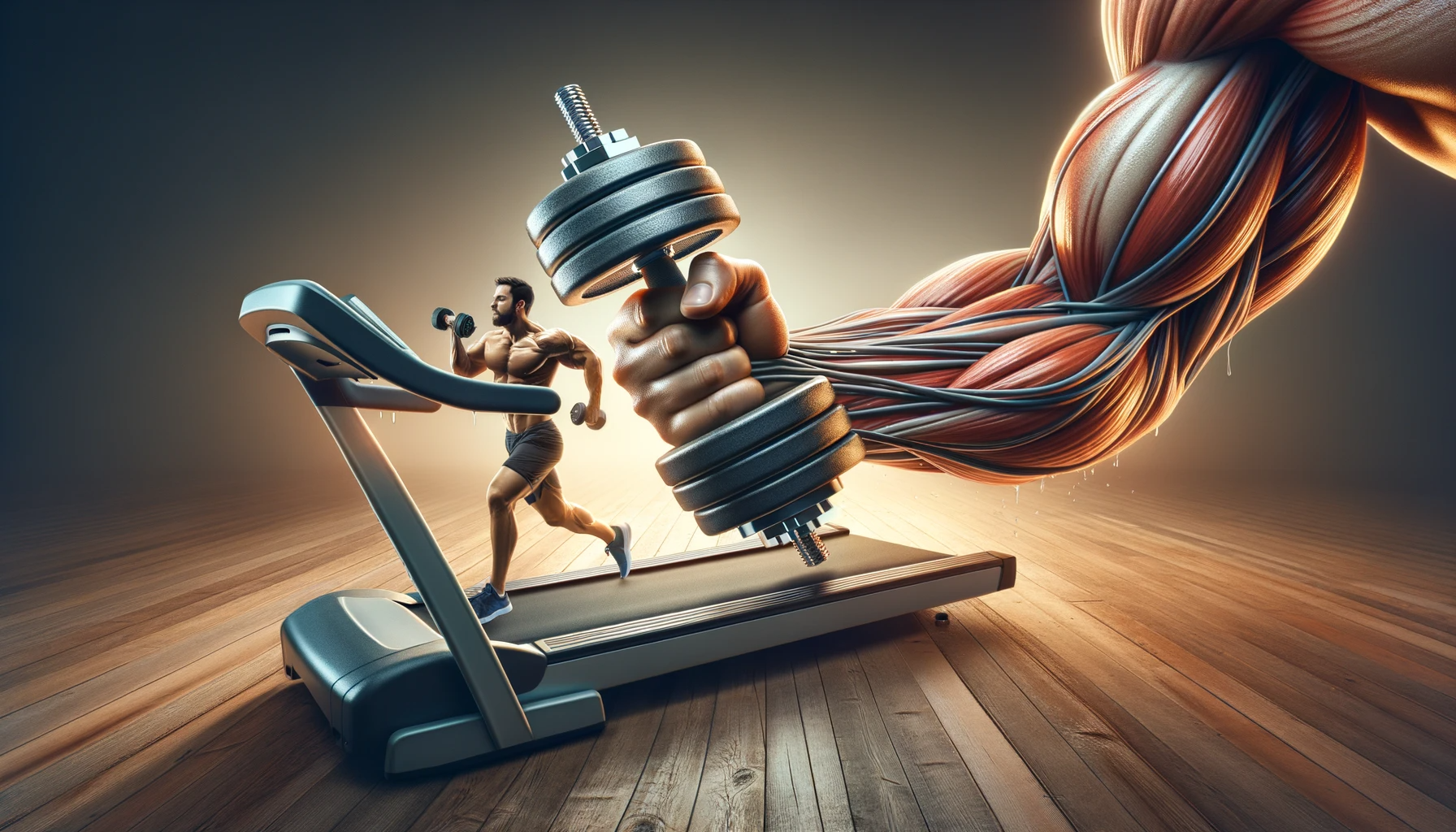
You're a skinny guy, and you've been hitting the gym with one goal: to bulk up and gain muscle.
But you're also hearing about the importance of cardio for overall health.
Now, you're stuck in a dilemma. Can you incorporate cardio into your bulking routine without sabotaging your muscle gains?
This guide is here to answer that question and provide you with a comprehensive plan to achieve the best of both worlds.
Yes, skinny guys can and should incorporate cardio into their workout routine, even when bulking.
The key is strategically including cardio that complements, rather than hinders, muscle gain.

Skinny guys often find it challenging to gain muscle for several reasons:

Let's get one thing straight: if you're a skinny guy aiming to bulk up, your mirror and your bodyweight scale are your best friends.
They're the ultimate tools to gauge your progress.
If you notice your weight dropping week to week, it's a red flag.
You're either doing too much activity or not eating enough.
The solution?
Either cut back on the cardio or up your caloric intake.
And when it comes to boosting calories, nothing beats a high-calorie smoothie.
Mix in some whey protein, nuts, oatmeal, and bananas, and you've got yourself a calorie bomb.

Cardiovascular exercise is essential for heart health, stamina, and endurance.
Research shows that combining resistance training with cardiovascular exercise can stimulate muscle hypertrophy.
So, cardio can be beneficial if you're looking to gain muscle.

Ah, the age-old debate: should skinny guys do cardio?
The answer isn't as straightforward as you might think.
Cardio has its merits, but it also has its drawbacks, especially for skinny guys.
The intent behind doing cardio while bulking is crucial.
Are you doing it for general health, or are you trying to accelerate fat loss while gaining muscle?
Understanding your intent can help you make an informed decision.

Contrary to popular belief, cardio doesn't necessarily "kill" muscle gains.
Research shows that moderate cardio can improve muscle recovery and growth to some extent.
The key is not to overdo it and to time it properly.
Muscle Protein Synthesis (MPS) is the process your body uses to build new proteins.
One study shows that cardio can increase MPS rates, which means it could potentially help with muscle growth.
However, excessive cardio can have the opposite effect, leading to muscle loss.
The key is moderation and timing.
If you're a skinny guy aiming to gain muscle, the mirror and the bodyweight scale are your best friends.
If your weight is dropping week-to-week, you're either not eating enough or doing too much activity.
The solution?
Caloric-dense smoothies or snacks between meals can help you maintain or even increase your weight.
Three times a week might sound like a lot, especially for skinny guys.
However, it depends on the type of cardio.
Light cardio can aid in muscle recovery and can be done more frequently.
High-Intensity Interval Training (HIIT) can be quite taxing and should be limited to once or twice a week.
When incorporating cardio into a muscle-building routine, timing is everything.
Doing cardio at the wrong time can interfere with your muscle gains, while doing it at the right time can actually enhance your overall fitness and even aid in muscle recovery.
Remember, the goal is to incorporate cardio in a way that complements your muscle-building goals, not hinders them.
By being strategic about when you do your cardio, you can reap the benefits of both cardio and weightlifting without sacrificing muscle growth.
If you're keen on working out four times a week, here's how you can balance cardio and lifting:
Notice that cardio is limited to once or twice a week and is scheduled on days that don't precede lower body lifting.
This is to ensure that your legs are fresh for squatting and deadlifting, which are crucial for overall muscle gain.
Note: Avoid doing cardio the day before you have leg day (squats, deadlifts, etc.).
High-Intensity Interval Training (HIIT) is a versatile form of exercise that can serve multiple purposes.
Not only does it improve cardiovascular health, but it also has the potential to count as a weight training session due to its high intensity.
This is particularly useful for those who want to work out more frequently but are concerned about overdoing cardio.
Squats are a compound exercise that requires a lot of energy and strength.
Doing cardio the day before your squat session can lead to muscle fatigue, reducing your performance and potentially affecting your muscle gains.
So, you're wondering if cardio is the gains goblin lurking in your workout routine.
Let's clear the air and get down to the nitty-gritty science.
The answer isn't as straightforward as you might think.
So, what's the bottom line?
Cardio can impact your muscle-building efforts but is not a complete deal-breaker.
The key is finding the right balance.

Let's dig a bit deeper into these cellular pathways.
The mTOR pathway is your muscle-building buddy, activated when you're lifting weights.
On the other hand, the AMPK pathway comes alive during cardio and can inhibit the mTOR pathway.
This clash can slow down muscle protein synthesis, which helps you build muscle.
Another angle to consider is energy depletion.
You will be drained if you run a 5K before hitting the weights.
Your lifting performance will suffer, and so will your gains.
So, how do you find that sweet spot?
Here are some quick tips:
By understanding the science and planning your workouts wisely, you can make cardio an ally, not an enemy.
It's all about balance.
Not all cardio is created equal, especially when you're a skinny guy aiming for muscle gains.
The type of cardio you choose can significantly impact your muscle-building journey.
Here are some cardio types that are generally more favorable for skinny guys:
The key takeaway here is to choose a form of cardio that you enjoy and can sustain in the long term.
The best cardio for you is the one you'll do consistently, which complements your weightlifting routine.
Blending cardio and weightlifting in a single workout routine can be like mixing oil and water; they don't always go together naturally.
However, with the right approach, you can make them complement each other to maximize both muscle gains and cardiovascular health.
By thoughtfully integrating cardio into your weightlifting routine, you can enjoy the best of both worlds without compromising your muscle gains.
It's all about balance and listening to your body.
What's the Best Type of Cardio for Skinny Guys?
The best type of cardio for skinny guys is generally low-intensity steady-state (LISS) or moderate-intensity cardio. These forms are less likely to interfere with muscle gains. For more on this, check out this hardgainer workout plan guide.
How Often Should Skinny Guys Do Cardio?
Skinny guys should aim for 1-2 cardio sessions per week, especially if the main goal is muscle gain. For more tips on rapid muscle gain, visit how to gain 10lbs of muscle quickly.
Can Cardio and Weightlifting Be Done on the Same Day?
Yes, cardio and weightlifting can be done on the same day, but it's generally better to do cardio after weightlifting. For a full program that incorporates both, see this 4-week full body program.
Does Cardio Burn Muscle?
Excessive cardio can interfere with muscle gains, but moderate cardio can actually aid in muscle recovery and overall health. For the best exercises for mass building, check out these best mass-building hardgainer exercises.
Should I Do Cardio on Rest Days?
Doing light to moderate cardio on rest days can be beneficial for overall health without affecting muscle gains. For more on what to eat before and after workouts, see this hardgainer nutrition guide.
How Can I Increase My Caloric Intake for Muscle Gain?
High-calorie smoothies and calorie-dense snacks can help you achieve a caloric surplus necessary for muscle gain.
Is HIIT Good for Skinny Guys?
HIIT can be effective for fat loss and can even help build muscle if done correctly. However, it's more intense and can burn more calories, so it should be done cautiously.
How Do I Balance Cardio with Caloric Intake?
Monitor your weight and adjust your caloric intake or cardio frequency accordingly. If you're losing weight, you may need to reduce cardio or increase calories.
What Are the Signs That I'm Doing Too Much Cardio?
If you're losing weight or feeling excessively tired, you may be doing too much cardio and should adjust your routine.
Can I Skip Cardio Altogether?
While you can focus solely on weightlifting, incorporating some form of cardio can provide comprehensive health benefits and can aid in muscle recovery.
Incorporating cardio into a skinny guy's workout routine doesn't have to be a daunting task.
With the right approach, you can enjoy the benefits of both cardio and weightlifting without compromising your muscle gains.
The key is to find a balance that works for you, both in terms of the type of cardio and the timing of your weightlifting sessions.
By being strategic and mindful about how you incorporate cardio into your muscle-building routine, you can achieve a well-rounded level of fitness that serves you in the long run.
It's all about balance, timing, and, most importantly, listening to your body.
Useful Links
 About FitFrek
About FitFrekFitFrek operates as an independent platform, offering comprehensive workouts, programs, routines, guides, and unbiased reviews to accelerate your progress. We pride ourselves on our honesty, delivering straightforward and candid insights. FitFrek does not offer medical advice, diagnosis, or treatment services.